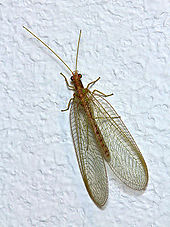Common lacewing
| Common lacewing | ||||||||||||
|---|---|---|---|---|---|---|---|---|---|---|---|---|

Common lacewing ( Chrysoperla carnea ) |
||||||||||||
| Systematics | ||||||||||||
|
||||||||||||
| Scientific name | ||||||||||||
| Chrysoperla carnea | ||||||||||||
| ( Stephens , 1836) |
The common lacewing or green lacewing ( Chrysoperla carnea s. L.) Is a reticulated wing fly of the family of lacewing (Chrysopidae). It was voted Insect of the Year in Germany in 1999 .
features
The animals reach a wingspan of 15 to 30 millimeters. They have a long and slender, green (or brown, see below) colored body. Their wings, which are laid out like a roof over the abdomen when at rest , have dense, green wing veins . Her hemispherical compound eyes are clearly protruding and shimmer in rainbow colors.
The otherwise green animals of the small species Ch. Carnea and Ch. Pallida turn brown before wintering and green again after wintering, while the individuals of Chrysoperla lucasina do not change their green body color.
As representatives of the subfamily Chrysopinae , the animals have a hearing organ at the base of the forewings.
Occurrence
The common lacewing occurs - except in Australia - worldwide from the lowlands to high altitudes and is widespread. Several overlapping generations develop each year.
Way of life
The most active dawn imagines feed on pollen , nectar and honeydew , which they of aphids get. During the day they sit hidden under leaves.
The animals overwinter as adults in dormancy in dry leaves or in sheltered places, such as in hollow tree trunks, in attics or in cracks in windows.
Mating and development
After hibernation, males ready to mate vibrate their abdomen to attract females. Females who sense such vibrations, in turn, begin vibrating. After mating, the females lay their eggs, which are attached to long stems, in rows on stems or leaves in the ground vegetation, on bushes or even on trees. The stalk consists of the secretion from the appendage glands of the genital apparatus, which solidifies very quickly. So the eggs should be protected from predators and cannibals. They are preferably set up near aphid colonies. Females can lay up to 20 eggs per day, depending on temperature and food, for a total of 400 to 700 eggs. Again, depending on the temperature, the development time of the eggs is three to ten days.
The larvae ( aphid lions ) feed in a predatory and polyphagous manner on various small insects, especially aphids, but also on cicadas , caterpillars, beetle larvae and mites. The larvae reach lengths of 7 to 8 mm and have three pairs of pectoral feet. The body is elongated and yellowish-gray in color. During their development, which can take 8 to 18 days depending on the temperature, they eat 200 to 500 aphids or up to 10,000 eggs and larvae of spider mites. This makes them popular as pest fighters and they are also bred for biological pest control . The prey is grabbed and pierced with suction tongs that have grown together from maxillae and mandibles . Then the victim is sucked out. The empty shells are then attached to bristles on the larvae's abdomen and serve as camouflage. The pupation takes place in a slightly transparent, round cocoon instead.
Taxonomy
The common lacewing is in the genus Chrysoperla in the tribe Chrysopini of the subfamily Chrysopinae within the family of lacewing (Chrysopidae).
The taxonomic status of the carnea complex is currently largely unclear. Under Chrysoperla carnea s. l. is currently understood as a complex of some cryptic small species that were separated from each other by a working group around Henry and Duelli due to the respective characteristic substrate vibrations ("promotional chants") of the groups (produced before copulation), the so-called "song morphs". A correlation with morphological features seems extremely difficult, however. It has not yet been convincingly clarified what taxonomic status the vibrational phena have. So far, the taxa Chrysoperla carnea s have been delimited at species level . st. ( Stephens , 1836) (ie the "real" Ch. Carnea ), Chrysoperla lucasina (Lacroix, 1912) and Chrysoperla pallens Henry, Brooks, Duelli & Johnson 2002. Other characteristic vibration phenomena ( "maltese" , "generator" etc.) are not yet finally clarified.
literature
- Horst Aspöck, Herbert Hölzel, Ulrike Aspöck: Annotated catalog of the Neuropterida (Insecta: Raphidioptera, Megaloptera, Neuroptera) of the Western Palearctic , Denisia 02, Linz 2001.
- Heiko Bellmann : The New Cosmos Insect Guide , Franckh-Kosmos Verlags-GmbH & Co, Stuttgart 1999, ISBN 3-440-07682-2 .
- Ekkehard Wachmann , Christoph Saure: Netzflügler, Mud and Camel Neck Flies , Naturbuch-Verlag, Augsburg 1997, ISBN 3-89440-222-9 .
Web links
Individual evidence
- ↑ Manfred Fortmann: The great cosmos book of beneficial insects . Franckh-Kosmos, Stuttgart 2000, ISBN 3-440-06588-X , p. 65.
- ↑ Manfred Fortmann: The great cosmos book of beneficial insects . Franckh-Kosmos, Stuttgart 2000, ISBN 3-440-06588-X , p. 64.
- ↑ The common lacewing. In: Fauna Europaea Database. European Commission under the Fifth Framework Program, accessed February 28, 2010 .


